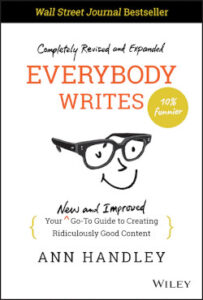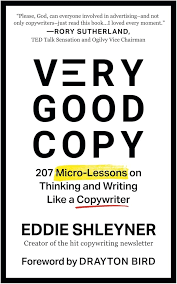Every fundraiser I know is obsessed with learning.
(The ones who think they can do it all with their innate talent never last very long.)
The great ones read every fundraising book they can get their hands on. They follow the blogs. They go to conferences as often as they can afford.
They also look beyond the fundraising world. Because there’s a lot of great material out there that’s not specifically about fundraising, but potentially transformative for the voracious, ambitious fundraiser.
I want to share two amazing books that have almost nothing to say about motivating donors to give. But a lot to say about writing. Which is the main ingredient for motivating donors to give.
I love both of these books, partly because they practice what they preach: They’re easy to read. In fact, they’re hard to stop reading. Full of energy and forward motion. Making and keeping compelling promises. Both are more than 400 pages, but they’re quick reads anyway.
If you can write the way these two authors do, you will raise a lot of money.
Everybody Writes: Your New and Improved Go-To Guide to Creating Ridiculously Good Content (2nd Edition) by Ann Handley
 I have to admit my shields went up when I first saw the word “content” in the title. It often means amateur or AI written garbage that I’d be ashamed to be associated with.
I have to admit my shields went up when I first saw the word “content” in the title. It often means amateur or AI written garbage that I’d be ashamed to be associated with.
But I’m glad I got past it, because this is a fantastic book. Its premise, as Ann writes in the “Start Here” section:
Writing well is part habit, part knowledge of some fundamental rule, and part giving a damn. We are all capable of producing good writing. We all have that magic within us.
I agree with that, even though the evidence – really terrible writing nearly everywhere you look in almost every situation – seems to suggest otherwise.
Most people are capable of writing well, and this book is a great place to start.
Its 91 chapters each zero in on something particular. To give you an idea what kinds of thing those chapters are about, here are the names of the six sections of the book:
- Writing Rules: How to Write Better (and How to Hate Writing Less)
- Writing Rules: Grammar and Usage
- Voice Rules
- Story Rules
- Publishing Rules
- 20 Things Marketers Write
Remember, this is not a book about raising funds. But it is remarkably helpful for fundraising. Here’s part of what chapter 12, “Pathological Empathy” has to say:
… empathy for the [donor] experience should be at the root of all of our content, because having a sense of the people you are writing for and a deep understanding of their problems is key to honing our craft.
It goes on to give the steps toward empathy (which I’ve slightly revised to make it more specifically about fundraising:
- Spend time with your [donors] or prospects.
- Understand their habitat.
- Ask why. Why they value and what they need from you.
- Share stories, not just stats.
- Use [donor]-centric language. Replace I or we with you.
- Aim to deliver an “It’s-me!” minute.
The conclusion: “The best way to keep people engaged is to talk about them. Not you.”
Do that, and you’ll raise a lot of money!
This book is packed full of wisdom like this. Highly recommended.
Very Good Copy: 207 Micro-Lessons on Thinking and Writing Like a Copywriter by Eddie Shleyner

If you don’t subscribe to the Very Good Copy newsletter, you should. It’s one of the best out there.
Or you could read this book. It’s a compilation from the newsletter.
A total of 207 chapters, all of them short … some of them very short. Here’s one of the chapters, “Length,” in full: “If your copy is fascinating, the length is irrelevant.” (There’s a truth you can take to the bank in fundraising. It’s a proven winner.
The cool thing about this book is you can read it any way you like: Start at the beginning and read through to the end. Or open it at random and read a chapter or two. Either way, you’ll learn useful things.
Here are some powerful fundraising lessons, selected from Very Good Copy.
Windows
Conversion copy should not call attention to itself. It should call attention to the prospect, to her problems. Or to the product, to the pleasure it produces or the pain it prevents. But not to itself.
The Time I Wasn’t Hired at Facebook
The chapter concludes with a quote from Zig Ziglar: “You will get all you want in life if you help enough other people get what they want.” If you’re a fundraiser, you might want to tattoo this someplace on yourself where you can see it!
Pain versus Pleasure
If given the choice between avoiding pain and attaining pleasure, people, like animals, will almost always choose the former. We jog to pleasure, but we sprint from pain.
The Magic Number
When possible, write three bullets, or three benefits, or three steps. Three is the magic number. If you can, avoid presenting information in twos or fours. It’s harder for The Reader to remember.
Heuristics
“Heuristic processing” helps us learn through cues and shortcuts, rather than critical thinking. Marketers and copywriters leverage this, especially something called the Length-Implies-Strength Heuristic, or LISH for short, which is based on the assumption that longer copy is more impressive believable. Therefore it’s more likely to persuade The Reader.
I’m tempted to go on (and on), but if you’re seeing the power of this, read the book. You’ll be glad you did.
Looking for some quick improvements to your fundraising? Get the Moceanic FREE Guide: 5 Donor Love Tips To Boost Your Fundraising In Hard Times. These are easy, proven tactics that help you connect with donors for more revenue, better retention, and stronger relationships. Click through for your copy today!
Related Blog Posts:










